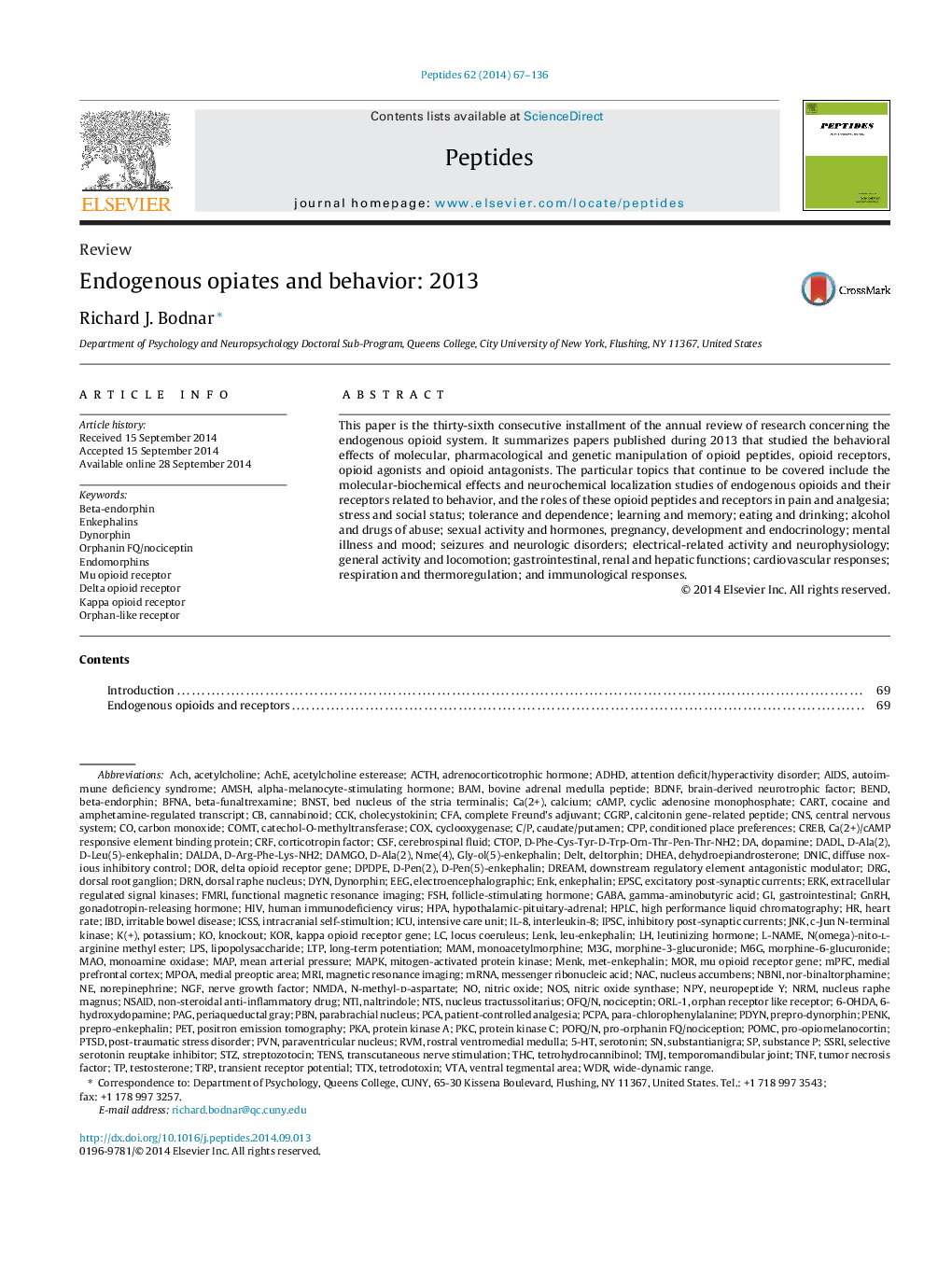| Article ID | Journal | Published Year | Pages | File Type |
|---|---|---|---|---|
| 2005998 | Peptides | 2014 | 70 Pages |
Abstract
This paper is the thirty-sixth consecutive installment of the annual review of research concerning the endogenous opioid system. It summarizes papers published during 2013 that studied the behavioral effects of molecular, pharmacological and genetic manipulation of opioid peptides, opioid receptors, opioid agonists and opioid antagonists. The particular topics that continue to be covered include the molecular-biochemical effects and neurochemical localization studies of endogenous opioids and their receptors related to behavior, and the roles of these opioid peptides and receptors in pain and analgesia; stress and social status; tolerance and dependence; learning and memory; eating and drinking; alcohol and drugs of abuse; sexual activity and hormones, pregnancy, development and endocrinology; mental illness and mood; seizures and neurologic disorders; electrical-related activity and neurophysiology; general activity and locomotion; gastrointestinal, renal and hepatic functions; cardiovascular responses; respiration and thermoregulation; and immunological responses.
Keywords
CREB5-HT6-OHDACFALPSCOXJnkDRGCPPTrpTHCMORmRNACatechol-O-methyltransferaseNSAIDNAC6-HydroxydopamineERKIBDMAMNOSNPYPOMCM3GCRFdehydroepiandrosteronepKaCCKNGFTTXCGRPNMDAN-methyl-d-aspartateMPFCPAGSTZCOMTVTADRNICSSTMJNTSpDynMAOPKCIPSCBNSTCARTexcitatory post-synaptic currentsRVMMPOAWDRpro-opiomelanocortinDNICCTOPPCPANRMMet-enkephalinIL-8EnkephalinsnociceptinNTIMENKd-Phe-Cys-Tyr-d-Trp-Orn-Thr-Pen-Thr-NH2DALDAC/PPBNDPDPEM6GCaudate/putamenORL-1ACTHTNFGnRHDHEAnBNIOFQ/NDADLDeltwide-dynamic rangedorsal root ganglioncomplete Freund's adjuvantBDNFc-Jun N-terminal kinasecAMPDAMGOEPSCl-NAMEMAPKOrphanin FQ/nociceptinPCACyclic adenosine monophosphateNaltrindolecyclooxygenaseAChAChEpost-traumatic stress disorderPTSDstreptozotocinAcetylcholinegamma-aminobutyric acidelectroencephalographicAMshMRIEndomorphinsEnkenkephalinAIDSInterleukin-8Beta-endorphinBeta-funaltrexamineICUintensive care unitBAMADHDirritable bowel diseasetetrodotoxinTranscutaneous Nerve StimulationtestosteroneMagnetic resonance imagingfMRIfunctional magnetic resonance imaginglong-term potentiationLTPPositron emission tomographyBFNAinhibitory post-synaptic currentsperiaqueductal graybendDORpatient-controlled analgesiaCNSGastrointestinalDeltorphinTENSDopaminedynorphinmessenger ribonucleic acidrostral ventromedial medullaDREAMSerotonincentral nervous systemHeart rateNon-steroidal anti-inflammatory drugnerve growth factorBrain-derived neurotrophic factortumor necrosis factormean arterial pressuremedial prefrontal cortexLeu-enkephalinLenklocus coeruleuslipopolysaccharideSubstance PPVNCerebrospinal fluidCSFDyntemporomandibular jointmedial preoptic areacarbon monoxideSelective serotonin reuptake inhibitorSSRIMorphine-3-glucuronideMorphine-6-glucuronidemonoamine oxidaseHPAventral tegmental areaknockoutmapEEGNor-binaltorphaminenorepinephrineNitric oxidenitric oxide synthaseNucleus accumbensparabrachial nucleusbed nucleus of the stria terminalisnucleus raphe magnusdorsal raphe nucleusparaventricular nucleusadrenocorticotrophic hormoneGonadotropin-releasing hormonealpha-melanocyte-stimulating hormonefollicle-stimulating hormoneFSHleutinizing hormonehypothalamic-pituitary-adrenalKORHIVhuman immunodeficiency virusPara-chlorophenylalaninePETPotassiumtransient receptor potentialprotein kinase AProtein kinase Cmitogen-activated protein kinasecalcitonin gene-related peptidePENKCannabinoidhigh performance liquid chromatographyHPLCCalciumAttention deficit/hyperactivity disorderDiffuse noxious inhibitory controlcholecystokininCocaine and amphetamine-regulated transcriptGABAkappa opioid receptorMu opioid receptordelta opioid receptorNeuropeptide Y
Related Topics
Life Sciences
Biochemistry, Genetics and Molecular Biology
Biochemistry
Authors
Richard J. Bodnar,
